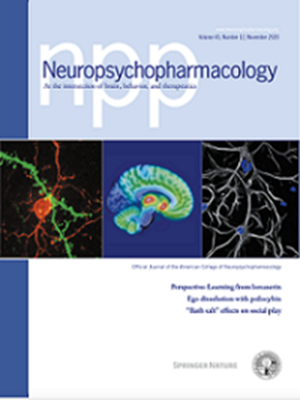Changes in nucleus accumbens core translatome accompanying incubation of cocaine craving
IF 6.6
1区 医学
Q1 NEUROSCIENCES
引用次数: 0
Abstract
In the ‘incubation of cocaine craving’ model of relapse, rats exhibit progressive intensification (incubation) of cue-induced craving over several weeks of forced abstinence from cocaine self-administration. The expression of incubated craving depends on plasticity of excitatory synaptic transmission in nucleus accumbens core (NAcC) medium spiny neurons (MSN). Previously, we found that the maintenance of this plasticity and the expression of incubation depends on ongoing protein translation, and the regulation of translation is altered after incubation of cocaine craving. Here we used male and female rats that express Cre recombinase in either dopamine D1 receptor- or adenosine 2a (A2a) receptor-expressing MSN to express a GFP-tagged ribosomal subunit in a cell-type specific manner, enabling us to use Translating Ribosome Affinity Purification (TRAP) to isolate actively translating mRNAs from both MSN subtypes for analysis by RNA-seq. We compared rats that self-administered saline or cocaine. Saline rats were assessed on abstinence day (AD) 1, while cocaine rats were assessed on AD1 or AD40-50. For both D1-MSN and A2a-MSN, there were few differentially translated genes between saline and cocaine AD1 groups. In contrast, pronounced differences in the translatome were observed between cocaine rats on AD1 and AD40-50, and this was far more robust in D1-MSN. Notably, all comparisons revealed sex differences in translating mRNAs. Sequencing results were validated by qRT-PCR for several genes of interest. This study, the first to combine TRAP-seq, transgenic rats, and a cocaine self-administration paradigm, identifies translating mRNAs linked to incubation of cocaine craving in D1-MSN and A2a-MSN of the NAcC.

可卡因渴求潜伏期伏隔核翻译体的变化。
在“可卡因渴望的潜伏期”复发模型中,大鼠在强制戒断可卡因自我给药的几周内,表现出线索诱导的渴望的进行性强化(潜伏期)。培养渴望的表达依赖于伏隔核(NAcC)中棘神经元(MSN)兴奋性突触传递的可塑性。先前,我们发现这种可塑性的维持和孵育的表达依赖于正在进行的蛋白质翻译,并且翻译的调节在可卡因渴望孵育后发生改变。在这里,我们使用在表达多巴胺D1受体或腺苷2a (A2a)受体的MSN中表达Cre重组酶的雄性和雌性大鼠,以细胞类型特异性的方式表达gfp标记的核糖体亚基,使我们能够使用翻译核糖体亲和纯化(TRAP)从两种MSN亚型中分离出积极翻译的mrna,用于RNA-seq分析。我们比较了自我注射生理盐水和可卡因的大鼠。生理盐水大鼠在戒瘾日(AD) 1进行评估,可卡因大鼠在戒瘾日(AD1)或戒瘾日(AD40-50)进行评估。对于D1-MSN和A2a-MSN,生理盐水组和可卡因AD1组之间几乎没有差异翻译基因。相比之下,在AD1和AD40-50的可卡因大鼠之间观察到翻译体的显著差异,并且在D1-MSN中更为明显。值得注意的是,所有的比较都揭示了mrna翻译的性别差异。对多个感兴趣的基因进行qRT-PCR验证测序结果。这项研究首次将TRAP-seq、转基因大鼠和可卡因自我给药模式结合起来,确定了与NAcC D1-MSN和A2a-MSN中可卡因渴求潜伏期相关的翻译mrna。
本文章由计算机程序翻译,如有差异,请以英文原文为准。
求助全文
约1分钟内获得全文
求助全文
来源期刊

Neuropsychopharmacology
医学-精神病学
CiteScore
15.00
自引率
2.60%
发文量
240
审稿时长
2 months
期刊介绍:
Neuropsychopharmacology is a reputable international scientific journal that serves as the official publication of the American College of Neuropsychopharmacology (ACNP). The journal's primary focus is on research that enhances our knowledge of the brain and behavior, with a particular emphasis on the molecular, cellular, physiological, and psychological aspects of substances that affect the central nervous system (CNS). It also aims to identify new molecular targets for the development of future drugs.
The journal prioritizes original research reports, but it also welcomes mini-reviews and perspectives, which are often solicited by the editorial office. These types of articles provide valuable insights and syntheses of current research trends and future directions in the field of neuroscience and pharmacology.
 求助内容:
求助内容: 应助结果提醒方式:
应助结果提醒方式:


